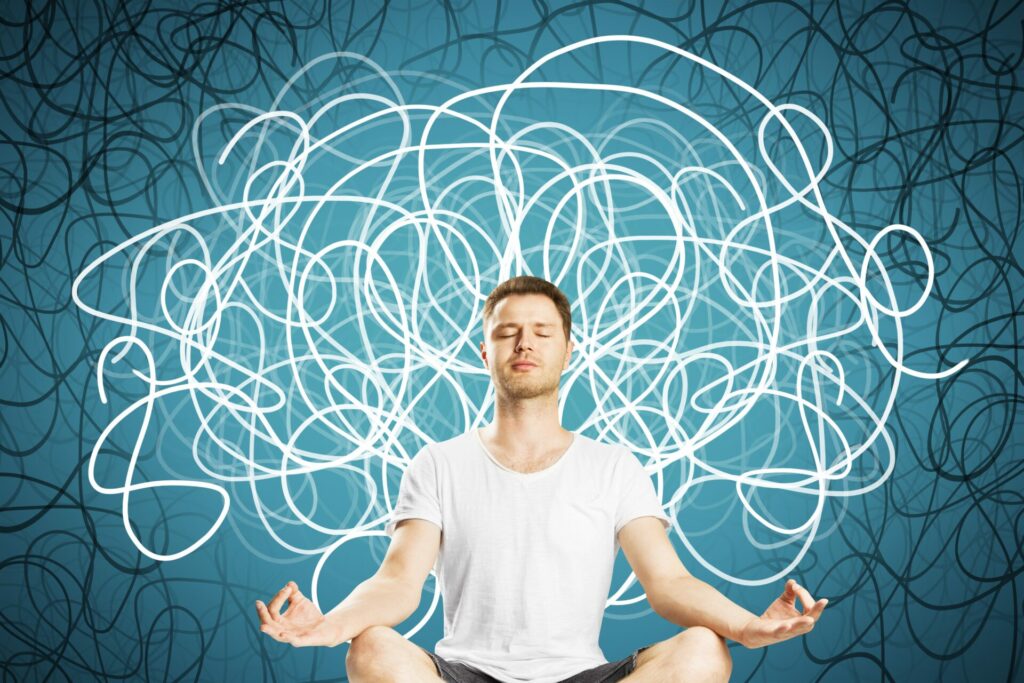Mindfulness for Stress:
Stress, a ubiquitous part of modern life, can significantly impact our health and well-being. Mindfulness-Based Stress Reduction (MBSR), pioneered by Dr. Jon Kabat-Zinn, offers a practical and structured approach to managing stress through mindfulness techniques. This blog post explores the foundations of MBSR, discussing how ‘mindfulness for stress’ is not just a concept, but a transformative practice with profound benefits.
The Genesis and Philosophy of MBSR
The MBSR program was developed in the 1970s at the University of Massachusetts Medical Center. Dr. Kabat-Zinn’s vision was to combine mindfulness meditation, drawn from Buddhist traditions, with contemporary clinical psychology. The core philosophy of MBSR revolves around mindfulness, which is the practice of paying attention in a particular way: on purpose, in the present moment, and nonjudgmentally.

Key Elements of MBSR
MBSR incorporates several practices, each contributing uniquely to stress reduction:
- Mindfulness Meditation: This practice involves focusing on the breath, observing thoughts and feelings as they arise, and learning to respond to them with equanimity.
- Body Scan Meditation: This technique involves mentally scanning one’s body for areas of tension and relaxation, enhancing body awareness.
- Gentle Yoga and Stretching: These practices help in releasing physical tension and improving the mind-body connection.
Mindfulness For Stress in Everyday Life
Integrating mindfulness into everyday life can transform mundane routines into moments of calm and clarity. The beauty of mindfulness is its simplicity and adaptability; it can be practiced anywhere, at any time, without the need for special equipment or extensive training. Here are some ways to weave mindfulness into the fabric of daily life:
- Morning Routine: Begin your day with a few minutes of mindfulness. This could be a short meditation, a mindful cup of tea, or simply sitting quietly and setting an intention for the day.
- Mindful Commuting: Transform your commute into a mindfulness practice. Pay attention to the sensations of walking, or if you’re driving, be fully present with the act of driving, observing sights, sounds, and sensations.
- Mindful Eating: Turn meals into an opportunity for mindfulness by eating slowly and savoring each bite. Notice the colors, textures, flavors, and smells of your food.
- Mindful Work: Incorporate mindfulness into your workday. Take short breaks to breathe mindfully, or bring full attention to each task, reducing multi-tasking where possible.
- Mindful Relationships: Practice active listening in conversations, giving your full attention to the other person without planning your response.
- Evening Wind-down: End your day with a mindfulness practice. Reflect on the day, write in a gratitude journal, or do a gentle body scan meditation before sleep.
Related Article: Mindfulness Meditation for Sleep and Anxiety: A Guide to Restful Nights
The Science of Mindfulness and Stress Reduction
Research has shown that mindfulness meditation can lower cortisol levels, the primary stress hormone. It also enhances the brain’s ability to process stress and emotions, particularly in areas like the amygdala and prefrontal cortex. This leads to better emotional regulation and reduced feelings of anxiety and depression.
Incorporating Mindfulness into a Busy Lifestyle
Adopting mindfulness doesn’t require drastic changes to one’s daily routine. Simple practices can be integrated seamlessly:
- Mindful Breathing: Just a few minutes of focusing on the breath can be a quick stress reliever.
- Micro-meditations: Short, one-minute meditations throughout the day can be refreshing and grounding.
- Mindful Observation: Engaging in a regular practice of observing your surroundings can enhance presence and reduce stress.
The Impact of Mindfulness on Physical Health
Beyond stress reduction, mindfulness has been shown to have a positive impact on various aspects of physical health, including:
- Improving Sleep: Mindfulness can enhance the quality of sleep, crucial for stress recovery.
- Chronic Pain Management: Mindfulness can alter the perception of pain and improve coping mechanisms.
- Boosting Immunity: Lower stress levels can lead to a stronger immune response.
Table: MBSR vs. Other Stress Reduction Techniques
| Stress Management Technique | Focus | Method | Benefits |
|---|---|---|---|
| Mindfulness-Based Stress Reduction (MBSR) | Mindfulness, meditation, and awareness | Practices include mindfulness meditation, body scans, and yoga | Enhances emotional regulation, reduces stress, improves physical well-being, and increases mindfulness in daily activities |
| Cognitive Behavioral Therapy (CBT) | Mental patterns and behaviors | Focuses on identifying and changing negative thought patterns and behaviors | Effective in treating anxiety and depression, improves mental health by changing thought processes |
| Physical Exercise | Physical activity and wellness | Involves engaging in physical activities like walking, running, yoga, or gym workouts | Reduces stress hormones, improves mood through endorphin release, enhances overall physical health, and improves sleep quality |
| Art and Music Therapy | Creative expression | Utilizes creative processes like painting, drawing, or making music | Provides emotional release, enhances self-expression, improves mood, and can be a meditative and relaxing experience |
Each of these techniques offers unique benefits and methods for managing stress. While MBSR focuses on mindfulness and awareness, CBT addresses mental patterns, physical exercise targets physical well-being, and art and music therapy provide creative outlets for emotional release and relaxation.
While MBSR is a comprehensive approach, it’s one of several methods available for managing stress:
- Cognitive Behavioral Therapy (CBT): Focuses on changing negative thought patterns.
- Physical Exercise: A well-known stress reliever that improves physical and mental health.
- Art and Music Therapy: Creative outlets that provide emotional release and relaxation.
MBSR in the Digital Age
The digital age has significantly expanded access to Mindfulness-Based Stress Reduction and its practices. With the rise of technology, mindfulness has become more accessible than ever before:
- Online MBSR Courses: There are numerous online platforms offering MBSR courses, making it convenient for individuals to participate from the comfort of their homes. These courses often include guided meditations, instructional videos, and community forums for discussion and support.
- Mindfulness Apps: Apps like Mindfulness.com, Headspace, Calm, and Insight Timer offer guided meditations, mindfulness exercises, and educational resources. They are particularly useful for those with busy schedules, allowing users to practice mindfulness on-the-go.
- Virtual Retreats and Workshops: Virtual retreats and workshops provide immersive mindfulness experiences, facilitated by experienced instructors. Participants can engage in deep practices without the need to travel.
- Social Media and Mindfulness Communities: Social media platforms have communities dedicated to mindfulness where individuals can find inspiration, share experiences, and connect with like-minded people.
- Research and Data Tracking: Wearable technology and apps now offer features for tracking meditation progress, monitoring stress levels, and providing feedback on physiological markers like heart rate variability, further integrating mindfulness into health and wellness technology.
The digital adaptation of MBSR and mindfulness practices not only broadens accessibility but also provides a diverse range of tools to suit different preferences and lifestyles. As we continue to navigate the challenges of the modern world, these digital resources play a crucial role in promoting mindfulness and well-being.
The Role of Mindfulness in Managing Work-Related Stress
Work-related stress is a significant concern for many. Mindfulness offers an effective way to manage this stress. By practicing mindfulness, individuals can learn to stay grounded in the present moment, reducing the impact of workplace pressures. Regular mindfulness practice can lead to improved focus, enhanced decision-making abilities, and better interpersonal relationships at work. It’s about cultivating a mindset that helps in responding to work challenges with clarity and calmness, rather than reacting impulsively.
Mindfulness and Its Connection to Emotional Intelligence
Emotional intelligence is the ability to understand and manage one’s own emotions and those of others. Mindfulness directly contributes to enhancing emotional intelligence. Through practices like mindful listening and non-judgmental observation, individuals can develop greater empathy and communication skills. This improvement in emotional intelligence can lead to stronger personal and professional relationships, as well as better conflict resolution skills.
The Journey of Mindfulness: Personal Stories and Experiences
Personal stories and experiences add a deeply human aspect to the concept of mindfulness. From individuals overcoming anxiety to those managing chronic illnesses, the stories of how mindfulness has transformed lives are both inspiring and informative. These narratives often highlight the adaptability of mindfulness practices to different life situations, offering real-world examples of how mindfulness can be integrated into daily routines.
Combining Mindfulness with Other Therapeutic Practices
Mindfulness can be effectively combined with other therapeutic practices for enhanced benefits. For instance, integrating mindfulness with cognitive-behavioral therapy (CBT) can provide a more holistic approach to managing anxiety and depression. Similarly, mindfulness practices complement physical therapies by promoting body awareness and aiding in pain management. This integrative approach can provide a more comprehensive path to healing and well-being.
Future Directions: Research and Developments in Mindfulness
The field of mindfulness is continually evolving, with ongoing research shedding new light on its benefits and applications. Future directions include exploring the use of mindfulness in diverse populations and settings, such as in schools, corporations, and healthcare. Additionally, technological advancements, like virtual reality mindfulness experiences, are opening up new possibilities for practice and accessibility. Keeping abreast of these developments can provide insights into the expanding scope of mindfulness in improving mental health and quality of life.
Final Thoughts | MBSR | Mindfulness For Stress
Mindfulness for stress, particularly through MBSR, is more than a technique; it’s a way of living. By embracing mindfulness, individuals can navigate life’s ups and downs with greater ease and resilience. Whether through structured programs like MBSR or through personal practice, mindfulness offers a path to a more balanced, peaceful, and fulfilling life. As we continue to understand and experience the benefits of mindfulness, it stands as a testament to the power of the present moment in transforming our lives.



